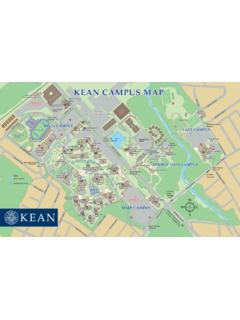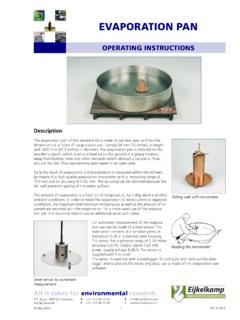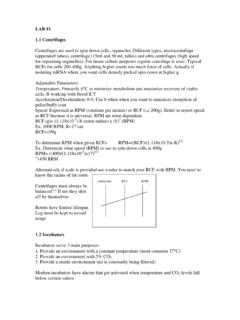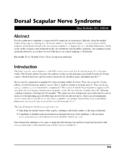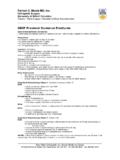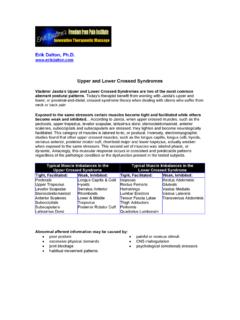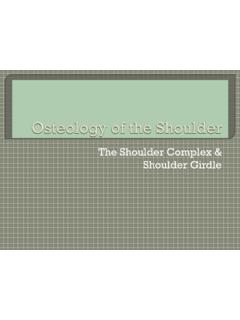Transcription of Chapter 4 The Shoulder Girdle - Kean University
1 1 McGraw-Hill Higher Education. All rights reserved. 4-1 Chapter 4 The Shoulder Girdle McGraw-Hill Higher Education. All rights reserved. 4-2 Bones Key bony landmarks Manubrium Clavicle Coracoidprocess Acromionprocess Glenoid fossa Lateral border Inferior angle Medial border McGraw-Hill Higher Education. All rights reserved. 4-3 Bones Key bony landmarks Acromionprocess Glenoid fossa Lateral border Inferior angle Medial border Superior angle Spine of the scapula From Seeley RR, Stephens TD, Tate P; anatomy and physiology, ed 7, New York, 2006, McGraw-Hill McGraw-Hill Higher Education. All rights reserved. 4-4 Joints Shoulder Girdle (scapulothoracic) scapula moves on the rib cage joint motion occurs at sternoclavicular joint & to a lesser amount at the acromioclavicular joint McGraw-Hill Higher Education.
2 All rights reserved. 4-5 Joints Sternoclavicular (SC) (multiaxial) arthrodial classification Movements anteriorly 15 degrees with protraction posteriorly 15 degrees with retraction superiorly 45 degrees with elevation inferiorly 5 degrees with depression McGraw-Hill Higher Education. All rights reserved. 4-6 Joints Sternoclavicular (SC) Ligamentous support anteriorly by the anterior SC ligament posteriorly by the posterior SC ligament costoclavicular & interclavicularligaments provide stability against superior displacement2 McGraw-Hill Higher Education. All rights reserved. 4-7 Joints Acromioclavicular (AC) arthrodial classification 20- to 30-degree total gliding & rotational motion accompanying other Shoulder Girdle & Shoulder joint motions supported by Coracoclavicular ligaments Superior acromioclavicular ligament Inferior acromioclavicular ligament often injured McGraw-Hill Higher Education.
3 All rights reserved. 4-8 Joints Scapulothoracic not a true synovial joint does not have regular synovial features movement depends on SC & AC joints which allows the scapula to move 25-degrees abduction-adduction 60-degrees upward-downward rotation 55-degrees elevation-depression supported dynamically by its muscles no ligamentous support McGraw-Hill Higher Education. All rights reserved. 4-9 Movements Focus on specific bony landmarks inferior angle glenoid fossa acromion process Shoulder Girdle movements = scapula movements McGraw-Hill Higher Education. All rights reserved. 4-10 Movements Abduction (protraction) scapula moves laterally away from spinal column Adduction (retraction) scapula moves medially toward spinal column McGraw-Hill Higher Education.
4 All rights reserved. 4-11 Movements Downward rotation returning inferior angle inferomedially toward spinal column & glenoid fossa to normal position Upward rotation turning glenoid fossa upward & moving inferior angle superolaterallyaway from spinal column McGraw-Hill Higher Education. All rights reserved. 4-12 Movements Depression downward or inferior movement, as in returning to normal position Elevation upward or superior movement, as in shrugging shoulders3 McGraw-Hill Higher Education. All rights reserved. 4-13 Movements Shoulder joint & Shoulder Girdle work together in carrying out upper extremity activities Shoulder Girdle movement is not dependent upon the Shoulder joint & its muscles McGraw-Hill Higher Education.
5 All rights reserved. 4-14 Movements Shoulder Girdle muscles Stabilize scapula so the Shoulder joint muscles will have a stable base from which to exert force for moving the humerus Contract to maintain scapula in a relatively static position during Shoulder joint actions Contract to move Shoulder Girdle & to enhance movement of upper extremity when Shoulder goes through extreme ranges of motion McGraw-Hill Higher Education. All rights reserved. 4-15 Movements For some Shoulder Girdle movements, scapula must rotate or tilt on its axis Lateral tilt (outward tilt) during abduction scapula rotates about its vertical axis resulting in posterior movement of medial border & anterior movement of lateral border Medial tilt (return from lateral tilt, inward tilt) during extreme adduction scapula rotates about its vertical axis resulting in anterior movement of medial border & posterior movement of lateral border McGraw-Hill Higher Education.
6 All rights reserved. 4-16 Movements Anterior tilt (upward tilt) rotational movement of scapula about frontal axis occurring during glenohumeral hyperextension superior border moving anteroinferiorly & inferior angle moving posterosuperiorly Posterior tilt (downward tilt) rotational movement of scapula about frontal axis occurring during glenohumeral hyperflexion superior border moving posteroinferiorly & inferior angle moving anterosuperiorly McGraw-Hill Higher Education. All rights reserved. 4-17 Movements Synergy with muscles of glenohumeral joint As Shoulder joint goes through more extreme ranges of motion, scapular muscles contract to move Shoulder Girdle so that its glenoid fossa will be in a more appropriate position from which the humerus can move Without the accompanying scapula movement humerus can only be raised into approximately 90 degrees of total Shoulder abduction & flexion McGraw-Hill Higher Education.
7 All rights reserved. 4-18 Movements Synergy with muscles of glenohumeral joint This works through the appropriate muscles of both joints working in synergy to accomplish the desired action of the entire upper extremity Ex. to raise our hand out to the side laterally as high as possible, the serratus anterior & trapezius(middle & lower fibers) muscles upwardly rotate scapula as supraspinatus & deltoid initiate glenohumeral abduction This synergy between scapula & Shoulder joint muscles enhances movement of entire upper extremity4 McGraw-Hill Higher Education. All rights reserved. 4-19 Shoulder GirdleMovementsElevationDepressionAbduct ionAdductionUpwardRotationDownwardRotati on McGraw-Hill Higher Education. All rights reserved. 4-20 Muscles 5 muscles primarily involved in Shoulder Girdle movements All originate on axial skelet on & insert on scapula and/or clavicle Do not attach to humerus & do not cause Shoulder joint actions Essential in providing dyn amic stability of the scapula so it can serve as a relative base of support for should er joi nt activities such as throwing, batting, & blo cking McGraw-Hill Higher Education.
8 All rights reserved. 4-21 Shoulder Girdle Muscles 5 muscles primarily involved in Shoulder Girdle movements Trapezius-upper, middle, lower Rhomboid -deep Levatorscapula Serratus anterior Pectoralis minor -deep McGraw-Hill Higher Education. All rights reserved. 4-22 Shoulder Girdle Muscles Location & action Anterior Pectoralis minor abduction, downward rotation, & depression Subclavius depression Posterior & laterally Serratus anterior abduction & upward rotation McGraw-Hill Higher Education. All rights reserved. 4-23 Shoulder Girdle Muscles Location & action Posterior Trapezius Upper fibers elevation & extension of the head Middle fibers elevation, adduction, & upper rotation Lower fibers adduction, depression, & upper rotation Rhomboid adduction, downward rotation, & elevation Levator scapulae elevation McGraw-Hill Higher Education.
9 All rights reserved. 4-24 Trapezius muscleLower fibers: depression, adduction, & upward rotationUpper fibers: elevation of scapula, extension & rotation of headMiddle fibers: elevation, upward rotation, & adduction5 McGraw-Hill Higher Education. All rights reserved. 4-25 Levator scapulae muscleElevates the medial margin of the scapula McGraw-Hill Higher Education. All rights reserved. 4-26 Rhomboid muscles - major & minorDownward rotation: from upward rotated position they draw scapula in downward rotationElevation: slight upward movement accompanying adductionRhomboid major & minor muscles work togetherAdduction (retraction): draw scapula toward spinal column McGraw-Hill Higher Education. All rights reserved. 4-27 Serratus anterior muscleUpward rotation: longer, lower fibers tend to draw inferior angle of scapula farther away from vertebrae, thus rotating scapula upward slightlyAbduction (protraction): draws medial border of scapula away from vertebrae McGraw-Hill Higher Education.
10 All rights reserved. 4-28 Pectoralis minor muscleAbduction (protraction): draws scapula forward & tends to tilt lower border away from ribsDepression: when scapula is rotated upward, it assists in depressionDownward rotation: as it abducts, it draws scapula downward McGraw-Hill Higher Education. All rights reserved. 4-29 Subclavius muscleStabilization & protection of sternoclavicular jointAbductionDepression McGraw-Hill Higher Education. All rights reserved. 4-30 Scapula Abduction Scapula move laterally away from spinous processes without rotation EX. Push-up & bench press Agonists Pectoralisminor Serratusanterior6 McGraw-Hill Higher Education. All rights reserved. 4-31 Scapula Adduction Return from abduction Occurs with retractions Agonists Middle Trapezius Rhomboids McGraw-Hill Higher Education.



